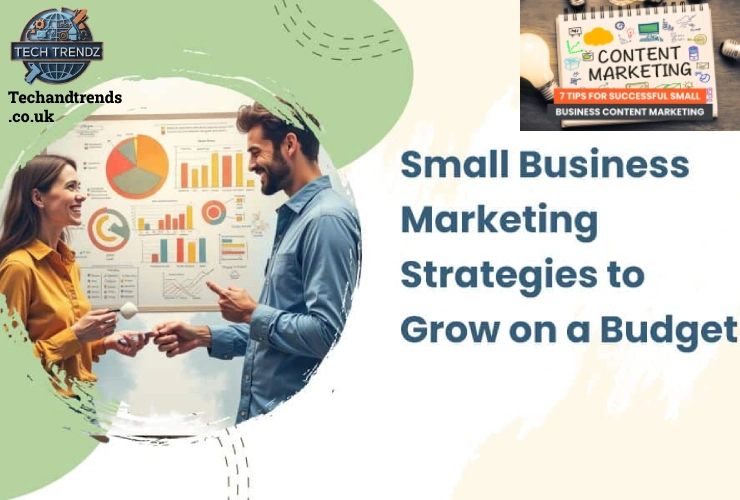Growing a small business quickly with limited resources is a challenge faced by entrepreneurs everywhere. The good news: you don’t need a massive budget or a big team to see real results. With the right strategies, you can outsmart-not outspend-your competition and accelerate your growth in 2025. This comprehensive Small Business Marketing Blog will walk you through the most effective, up-to-date, and budget-friendly marketing tactics for small businesses, backed by real data and expert insights.
Why Smart Marketing Matters for Small Businesses
Small businesses operate with tighter budgets and fewer resources than large corporations. Every marketing dollar must work harder, and every campaign must deliver measurable results. The key to fast growth is focusing on high-impact, cost-effective strategies that maximize visibility, build trust, and create loyal customers-without burning through cash.
Effective Strategies for Small Business Marketing Blog Success
Creating an effective Small Business Marketing Blog is essential for entrepreneurs looking to grow quickly on a budget. By sharing valuable insights, practical tips, and real-world examples, your blog can attract and engage your target audience, build trust, and position your business as an industry leader-all without breaking the bank.
1. Establish a Strong Online Presence Immediately
Your website and digital footprint are your storefronts in the modern marketplace. In 2025, customers expect to find and interact with businesses online, whether you’re local or global.
- Optimize your website for mobile devices and fast loading speeds.
- Use SEO best practices: Incorporate relevant keywords, create valuable content, and ensure your site is easy to navigate.
- Claim and optimize your Google Business Profile for local search visibility.
Pro Tip: Even a simple, well-designed website can outperform a flashy one if it loads quickly, answers customer questions, and makes it easy to contact you.
2. Define Your Target Audience
Don’t waste time and money marketing to everyone. Clearly identify your ideal customer based on demographics, interests, and behaviors.
- Use tools like Google Analytics and Facebook Audience Insights.
- Conduct customer surveys to refine your understanding.
- Create detailed buyer personas to guide your messaging and channel selection.
Why it matters: Targeted marketing ensures your efforts reach the people most likely to buy, boosting ROI and speeding up growth.
| Read More |
|---|
| Jamie Siminoff Net Worth |
| Simon Cowell Accident |
| JB Mauney Net Worth |
| Jon Favreau Net Worth |
| Josh Altman Net Worth |
3. Leverage Social Media for Quick Wins
Social media remains one of the most cost-effective ways to reach new customers and engage your audience.
- Choose the right platforms: Instagram and TikTok for visual content and younger audiences; LinkedIn for B2B; Facebook for local communities.
- Post consistently: Share a mix of educational, entertaining, and promotional content.
- Use short-form video: Video content, especially Reels and TikToks, is prioritized by algorithms and highly engaging.
- Respond to comments and messages quickly to build relationships and trust.
Paid Social on a Budget: Even $5–$10 per day can generate leads if you target narrowly and promote your best-performing posts. Retargeting ads are especially effective for converting website visitors who didn’t buy the first time.
4. Invest in Content Marketing and SEO for Sustainable Growth
Content marketing and SEO drive organic (unpaid) traffic to your website, building authority and trust over time.
- Start a blog: Answer common customer questions, share how-tos, and provide value.
- Create evergreen content: Articles and guides that remain relevant over time.
- Optimize every post for SEO: Use relevant keywords, internal links, and meta descriptions.
- Repurpose content: Turn blog posts into social media snippets, infographics, or videos.
Why it works: SEO and content marketing bring in high-intent visitors who are actively looking for your products or services, reducing your reliance on paid ads.
5. Use Email Marketing to Nurture and Convert Leads
Email remains one of the highest-ROI marketing channels for small businesses.
- Build your list: Offer lead magnets (free guides, discounts) in exchange for email addresses.
- Send regular newsletters: Share updates, tips, and exclusive offers.
- Segment your list: Personalize emails based on customer interests and behaviors.
- Automate follow-ups: Use tools like Mailchimp or ConvertKit to send welcome sequences and abandoned cart reminders.
Pro Tip: Focus on providing value, not just promotions, to keep subscribers engaged and reduce unsubscribes.
6. Build Relationships Both Online and Offline
Trust and word-of-mouth are powerful growth drivers for small businesses.
- Engage with your local community: Sponsor events, partner with other businesses, or participate in local markets.
- Encourage reviews and testimonials: Positive reviews on Google and social media boost credibility and search rankings.
- Network online: Join industry groups, participate in forums, and collaborate with micro-influencers in your niche.
Community-building tip: Host webinars or live Q&A sessions to showcase your expertise and interact directly with potential customers.
7. Embrace Organic Marketing and Authentic Content
Consumers in 2025 are increasingly skeptical of traditional ads. Authentic, organic content builds trust and stands out in a crowded marketplace.
- Share real stories: Highlight customer success stories, behind-the-scenes moments, and your business journey.
- Partner with micro-influencers: These creators have smaller but highly engaged audiences and are more affordable than celebrity influencers.
- Encourage user-generated content: Ask customers to share photos or reviews using your product.
Why it works: Organic content continues to deliver value long after it’s posted, unlike paid ads that stop working when you stop spending.
8. Smart Paid Advertising on a Tight Budget
Paid ads can deliver fast results if used wisely.
- Start small: Test campaigns with minimal spend on platforms like Facebook, Instagram, or Google Ads.
- Use retargeting: Show ads to people who have already visited your website or engaged with your content.
- Focus on high-intent keywords: In Google Ads, target search terms that indicate a readiness to buy.
- Monitor and optimize: Track performance closely and double down on what works.
Pro Tip: Avoid broad, generic targeting. The more specific your audience, the better your results per dollar spent.
9. Offer Referral Incentives
Your existing customers are your best marketers. Encourage them to refer friends and family with simple incentives.
- Discounts or freebies for successful referrals.
- Loyalty programs that reward repeat business and word-of-mouth.
Why it works: Referred customers tend to have higher trust and convert faster, accelerating your growth at minimal cost.
10. Use Free and Low-Cost Tools to Maximize Efficiency
There are more free or affordable marketing tools than ever before, allowing small businesses to compete with larger brands.
- Google Analytics: Track website traffic and conversions.
- Canva: Create professional graphics for social media and email.
- Mailchimp, ConvertKit, or ActiveCampaign: Automate email marketing.
- Social media schedulers: Plan posts in advance to save time.
AI-powered chatbots can also help capture leads and engage website visitors 24/7, even if you’re on a budget.
11. Monitor, Measure, and Adjust Your Strategy
You can’t improve what you don’t measure. Regularly track your marketing performance and make data-driven decisions.
- Define clear KPIs: Website traffic, conversion rate, email open rates, customer acquisition cost, etc.
- Use analytics tools to see what’s working and what isn’t.
- Be flexible: Don’t be afraid to pivot if a strategy isn’t delivering results. Double down on what works best.
12. Plan Your Content in Advance, But Stay Flexible
Consistency is crucial for building momentum, but so is agility.
- Create a content calendar: Align posts with seasonal events, product launches, and audience needs.
- Leave room for trends: Be ready to capitalize on viral moments or shifts in your industry.
Why it matters: Planned content keeps your brand top-of-mind, while flexibility ensures you stay relevant and responsive.
13. Build Community, Not Just Campaigns
Modern marketing is about fostering genuine connections, not just pushing products.
- Engage with your audience: Respond to comments, ask for feedback, and show appreciation.
- Host or sponsor local events: In-person connections drive loyalty and word-of-mouth.
- Create online groups or forums: Bring your customers together to share experiences and ideas.
Community-building tip: Businesses that invest in relationships see higher retention and more organic growth over time.
14. Avoid Common Marketing Mistakes
Many small businesses waste time and money on ineffective tactics. Avoid these pitfalls:
- Inconsistent marketing efforts: Sporadic campaigns don’t build momentum.
- Ignoring SEO and search ads: Over 60% of small businesses aren’t investing here, missing out on high-intent customers.
- Neglecting reputation management: Online reviews and listings have a direct impact on purchasing decisions.
- Failing to track ROI: If you don’t measure results, you can’t improve or scale your efforts.
2025 Marketing Trends to Watch
Stay ahead of the curve by embracing these trends:
- Community-first marketing: Build loyal audiences, not just one-off sales.
- Micro-influencer partnerships: Authenticity over reach.
- AI-powered personalization: Use AI tools to tailor messages and automate tasks.
- Short-form video dominance: Platforms like TikTok and Instagram Reels continue to grow.
- Integrated search strategies: Combine SEO and paid search to “own” the top of Google results.
Sample Budget-Friendly Marketing Plan
| Tactic | Cost Range | Expected Impact |
|---|---|---|
| Social Media Marketing | Free – $100/mo | Fast audience growth, engagement |
| Content Marketing/SEO | Free – $200/mo | Long-term organic traffic |
| Email Marketing | Free – $50/mo | High ROI, nurture leads |
| Paid Social Ads | $5–$10/day | Immediate leads, retargeting |
| Referral Program | Cost of discount | Word-of-mouth, trust |
| Community Events | Free – $200 | Local brand awareness |
| AI Chatbot | Free – $50/mo | 24/7 lead capture |
Conclusion: Grow Fast, Spend Smart
Small business marketing in 2025 is about working smarter, not harder. By focusing on the right mix of organic content, targeted paid ads, community-building, and data-driven optimization, you can accelerate your growth-even on a tight budget. Remember, consistency, authenticity, and customer-centricity are your greatest assets. Start with a few of these strategies, track your results, and scale what works best for your unique business.


Comments are closed.